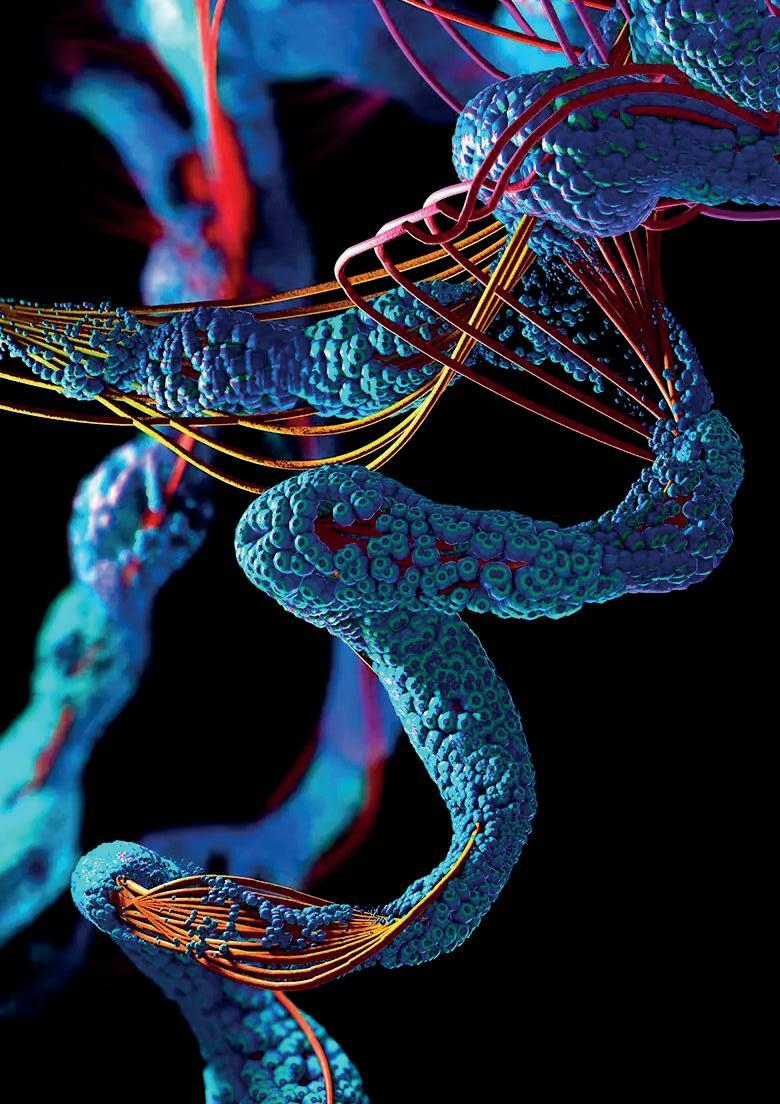
23 minute read
ALPHAFOLD
What Is It and Does it Really Solve the Protein Folding Problem?
By Gloria Kan
Traditionally, X-ray crystallography has always been the principal technique used to determine the complex 3D structure of proteins, especially for small, soluble proteins [6]. It goes through the following stages:
1. Crystallisation; this is when a pure, highly concentrated sample of protein is crystallised. pH, concentration, temperature and additive inclusion are controlled to optimise the yield and quality of protein crystals suitable to determine the structure of a protein.
2. A single X ray beam is generated by accelerating electrons caused by an electron striking a copper anode, and it is passed through slits that are approximately 0.1-0.3 mm wide, which causes diffraction (the spreading out of waves) [2].
3. A CCD (charge-coupled device) collects the X-ray diffraction images; it is generally preferred over conventional X-ray film or imaging plates due to its high level of sensitivity and the fact that the images can be collected rapidly (in a matter of seconds).
4. Resolution is calculated; it is important for it to be 1.5-3 Å (1Å is 1x10^−10 m), ensuring all amino acid side chains can be identified. (For reference, a carbon bond is approximately 1.5 Å) [2].
5. Data can then be collected for an electron density map, and analysed for a final structure.
Another rapidly advancing procedure is single-particle cryo-electron microscopy (cryo-EM) [1], a method that is most prominent in identifying larger protein structures. Its procedures are [3]:
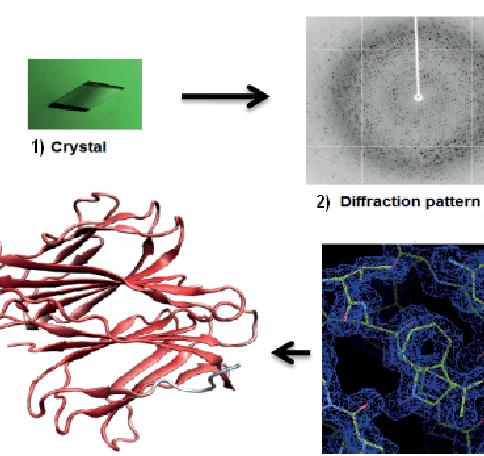
1. Apply a pure protein sample to a grid with small holes in its film.
2. Put the grid into a cryogen (a gas at a very low temperature; an example may be liquid nitrogen) to flash-freeze and trap particles in a thin film of vitreous ice. This is to protect the sample from any damage caused by radiation.
3. In the transmission electron microscope, a low electron dose is used to reduce damage done to the sample. As signals can be weak, many particles from the sample are analysed by a computer algorithm, to form one image of the particle; this is known as particle averaging.
4. Many 2D views of the protein obtained from different angles are processed to align images and merge data for a 3D map. Instead of having to convert electrons to photons, direct detectors can now detect electrons directly, allowing images to be recorded like a movie, resulting in a higher resolution (as motion correction can be used to reduce radiation drift) .
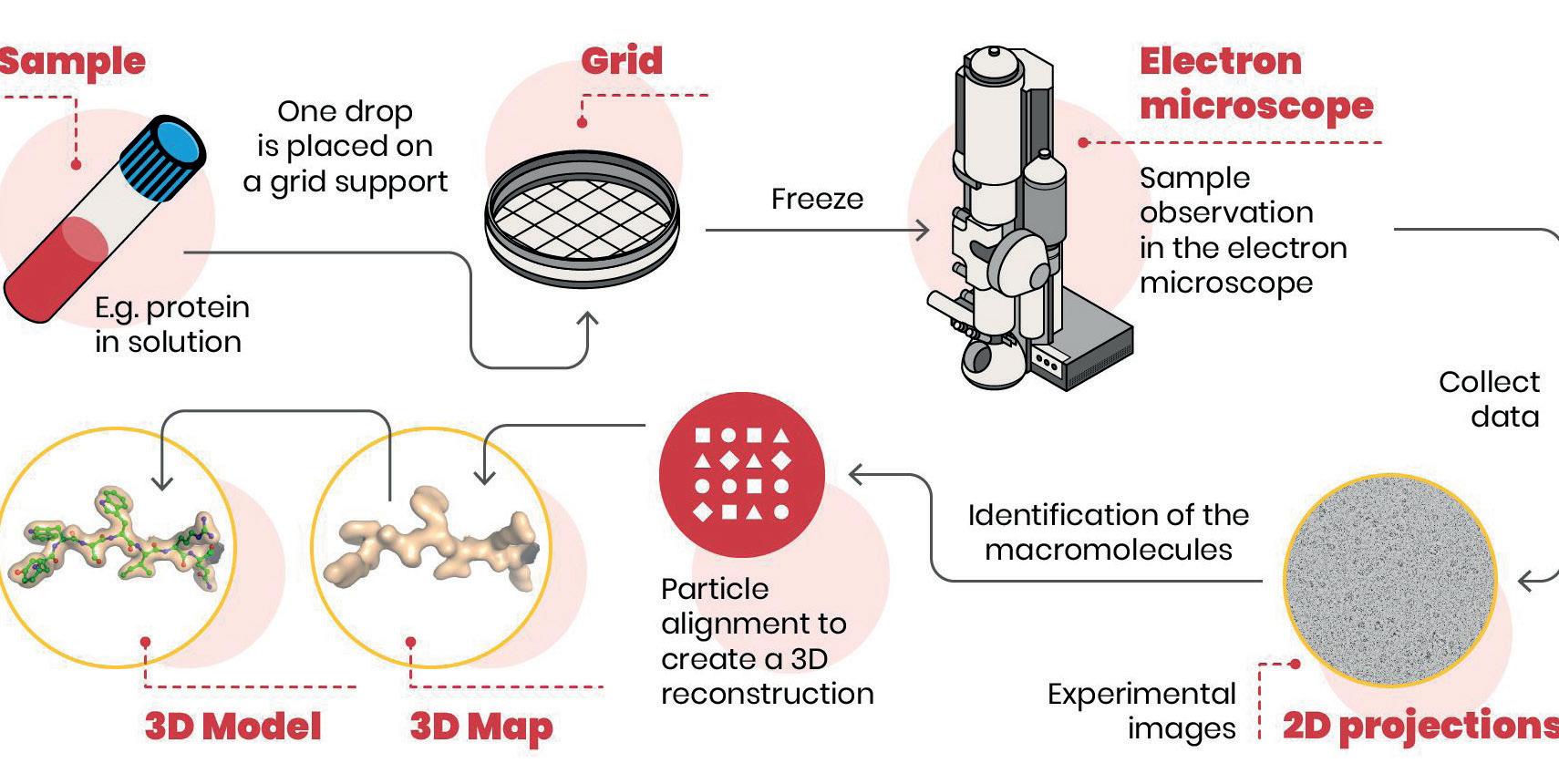
5. The main protein sequences are then fitted into a 3D map for a 3D model of the protein.
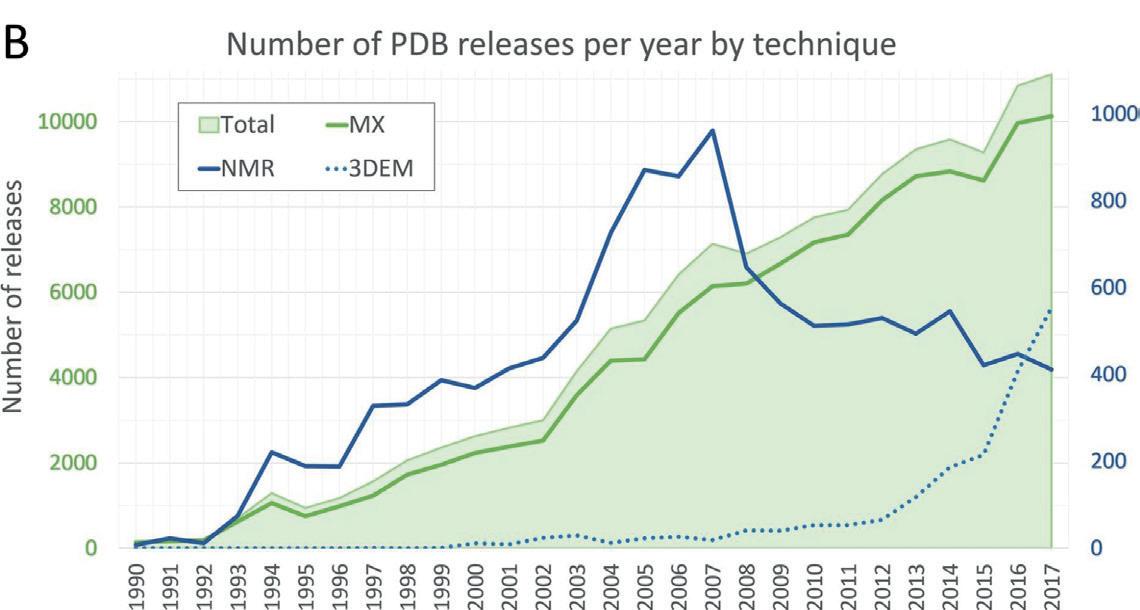
There is also NMR (Nuclear Magnetic Resonance) spectroscopy [4]. Its method is as follows:

1. Put the sample into a strong magnetic field —the stronger it is, the more detailed molecules can be studied, causing some atomic nuclei to act as small magnets.
2. When a range of frequencies is applied to it, the nuclei resonate at specific frequencies.
3. These frequencies of the nuclei are measured and analysed on a spectrum where intensity increases with larger resonating nuclei.
4. The value of the frequency gives information about the relative positions of atoms.
5. By examining the cross peaks of intensity, scientists can determine the 3D structures of proteins.
Unfortunately, these methods can be very time-consuming and expensive, as it can take anytime from a few months to years of painstaking effort for one protein structure to be identified by a research lab. Before AlphaFold, it took over 50 years of arduous experimental efforts for scientists to identify the structures of approximately 100,000 proteins (around 50,000 being human protein structures). However, despite this impressive number, it is only about 17% of the human proteins, and many structures only cover a fragment of the sequence [8]. Thus, AlphaFold is a great advancement in the realm of biology, as it can predict protein structures quickly with a fairly high level of confidence.
2. The history of AlphaFold (A7D and CASP13)
It all started when DeepMind, the developer of AlphaFold (previously known as A7D), entered CASP13 (the critical assessment of protein structure prediction), a prestigious competition that has been running since 1994 [7]. For fairness, they use a system of blind testing, a method of testing the entrants’ modelling systems with the structures (of recently discovered proteins) that haven’t been input into the protein data bank yet.
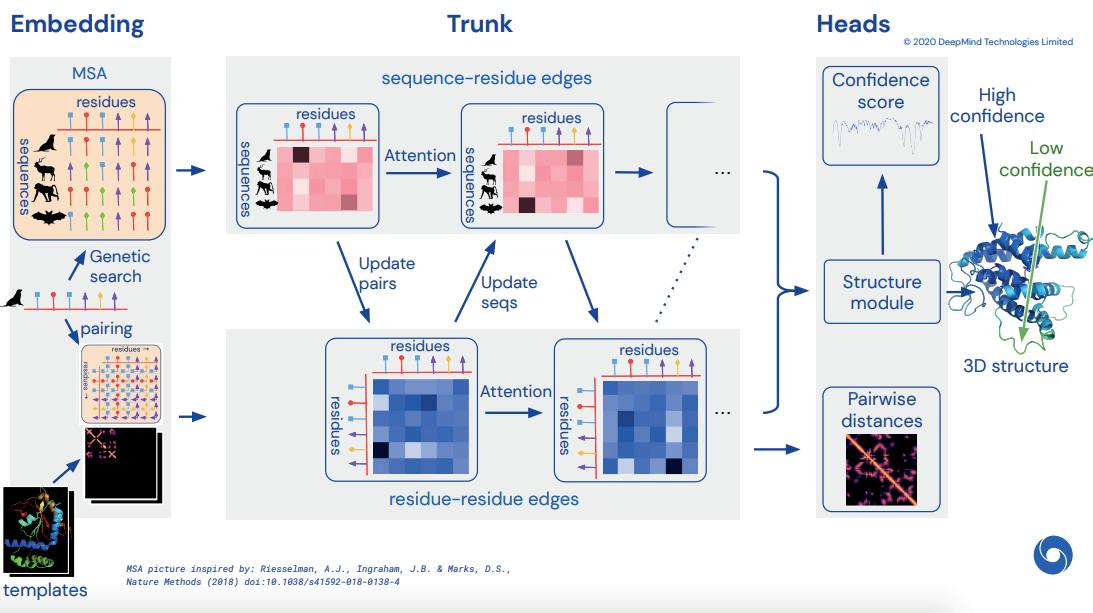
In CASP13, DeepMind’s model structure, A7D, secured them the top place in the competition. They used three different free-modelling methods; a GDT-net, a gradient descent to predict backbone structure, and a distance potential fragment assembly, with the gradient descent method achieving the highest scores and high accuracy structures (GDT_TS, a measure of the similarity of a model and a predicted structure scores of 70 or higher out of a 100 being predicted in) being predicted for 11/43 GDT-net proteins [10].
Its overall design combined predictions of several neural networks that estimated the distances between the carbon atoms of pairs of residues, since residues may have been positioned closely together even if they weren’t close in the sequence of amino acids. As a result, a contact map with data about distances and angles for each residue could be used to predict a 3D structure.
However, with A7D, overfitting was present; interactions between residues were over accounted for, and, as a result, models were believed to have more secondary structures when it wasn’t necessarily true (i.e. the AI believed that the protein had more alpha helices and beta pleated sheets than interactions between tertiary or quaternary structures).
restraints, violations of any constraints (especially peptide bond geometry, as it is less controlled in the structure module) can be resolved with coordinate restrained gradient descent.
As for the results achieved in CASP14, AlphaFold 2 received an overall z-score (indicating similarity between two protein models) of 244.0217, while the next best group scored 90.8241. Moreover, AlphaFold managed the best prediction out of all participants for 88 out of 97 of targets, with levels of accuracy equivalent to experimental x-ray crystallography.
Since CASP13, AlphaFold has gone through drastic improvements. First, the AlphaFold network can now directly predict the 3D coordinates of a given protein using the primary amino acid sequence as inputs [9]. It starts by employing Multiple Sequence Alignments (MSAs) with different regions weighted by importance (attention) through repeated layers of a novel neural network block (also known as Evoformer) [11]. Then, in the trunk, it extracts information about the relationships between the protein sequence and template structure, producing a Seq N x Res N array (where Seq N is the number of sequences and Res N is the number of residues); residues are also known as unique R groups in an amino acid giving it its properties. Furthermore, in the trunk, there are regular updates about the relationship between the sequence-residue and residue-residue edges of a graph in order to achieve consistency and fit the constraints.
In the head, the structure module treats the protein as if it is a residue gas moving around the network to generate the protein’s 3D structure. Initially, rotations are set to identity and all positions are at the origin, but a protein structure is swiftly developed. And, unlike A7D, end-to-end folding is used instead of gradient descent, and the 3D transformer directly operates on a rigid 3D backbone using pair representation and the original sequence row from the MSA to build the side chains.
After that, there is the refinement step, which ‘refines’, or improves the accuracy and stereochemical qualities of the protein, and a step known as relaxation. As the result isn’t guaranteed to obey all stereochemical
4. Limitations
However, AlphaFold cannot perfectly predict protein structures. Some predictions made by AlphaFold fail to reach a high level of accuracy in CASP14. T1047s1-D1, for example, only managed a median accuracy value of 50.47 (out of 5 models) with a long beta sheet at a completely incorrect angle from the domain (the rest of the structure), and this is thought to be due to it having “a very high oligomerization state (quaternary structure)” and a “lack of other intra-domain structure” [12]. Thus, it can be discerned that it is very difficult for AlphaFold to predict proteins consisting of one or more polypeptides.
Furthermore, AlphaFold can only predict backbone and side chain structure for a particular conformational state (i.e. active or inactive), so, at times, the predicted conformation isn’t necessarily the conformation that would be found in an experiment. An example would be Model 1 of T1024, where the wrong state was thought to be predicted, resulting in a low accuracy prediction. Areas that are “intrinsically disordered or unstructured in isolation” will also predict a “ribbon-like appearance”, leading to low confidence as its structure in different conformations is not certain.
Finally, AlphaFold only focuses on amino acid sequences, so it doesn’t take into account any other ions, DNA, RNA, ligands, metals, or cofactors. For instance, AlphaFold would not have been able to accurately predict the structure of haemoglobin, as it consists of haem groups. In addition, PTMs (post translational modifications) that may alter the structure of a protein dramatically aren’t considered, and the AI cannot predict the effect of mutations either.
5. Conclusion
Ultimately, AlphaFold is undoubtedly a revolutionary computational method that can accelerate the process of discovering proteins exponentially, especially since 98.5% of full chain human proteins can be predicted by AlphaFold [8]. While it cannot replace existing experimental methods or solve the protein folding problem, it can act as a guide for scientists to use, providing them with hypotheses for the structure of a protein.
6. Bibliography
[1] Thompson, Michael C., et al. “Advances in Methods for Atomic Resolution Macromolecular Structure Determination.” F1000Research, F1000Research, 2 July 2020.https://f1000research.com/articles/9-667/v1
[2] Smyth, M S, and J H Martin. “X Ray Crystallography.” Molecular Pathology : MP, U.S. National Library of Medicine, Feb. 2000. https:// www.ncbi.nlm.nih.gov/pmc/articles/PMC1186895/
[3] Doerr, Allison. “Single-Particle Cryo-Electron Microscopy.” Nature News, Nature Publishing Group, 30 Dec. 2015. https://www.nature.com/ articles/nmeth.3700
[4] Zinkel, Brian. “What Is NMR Spectroscopy and How Does It Work?” Nanalysis, Nanalysis, 28 June 2019.https://www.nanalysis.com/ nmready-blog/2019/6/26/what-is-nmr-spectrography-and-how-does-it-work#:~:text=How%20Does%20NMR%20Actually%20Work,at%20 their%20own%20specific%20frequencies
[5] “Protein Data Bank: the Single Global Archive for 3D Macromolecular Structure Data.” Academic.oup.com, 8 Jan. 2019. https://academic. oup.com/nar/article/47/D1/D520/5144142
[6] Jaskolski, Mariusz, et al. A Brief History of Macromolecular Crystallography, Illustrated by a ... 3 Apr. 2014. https://febs.onlinelibrary.wiley. com/doi/10.1111/febs.12796
[7] Jumper, John, et al. “Highly Accurate Protein Structure Prediction with Alphafold.” Nature News, Nature Publishing Group, 15 July 2021. https://www.nature.com/articles/s41586-021-03819-2
[8] Tunyasuvunakool, Kathryn, et al. “Highly Accurate Protein Structure Prediction for the Human Proteome.” Nature News, Nature Publishing Group, 22 July 2021.https://www.nature.com/articles/s41586-021-03828-1
[9] Skolnick, Jeffrey, et al. “Alphafold 2: Why It Works and Its Implications for Understanding the Relationships of Protein Sequence, Structure, and Function.” Journal of Chemical Information and Modeling, U.S. National Library of Medicine, 25 Oct. 2021. https://www.ncbi.nlm.nih.gov/ pmc/articles/PMC8592092/
[10] Senior, Andrew W., et al. Protein Structure Prediction Using Multiple Deep ... - Wiley Online Library. 10 Oct. 2019. https://onlinelibrary. wiley.com/doi/full/10.1002/prot.25834
[11] Skolnick, Jeffrey, et al. “Alphafold 2: Why It Works and Its Implications for Understanding the Relationships of Protein Sequence, Structure, and Function.” Journal of Chemical Information and Modeling, U.S. National Library of Medicine, 25 Oct. 2021. https://www.ncbi.nlm.nih.gov/ pmc/articles/PMC8592092/
[12] Jumper, John, et al. Applying and Improving Alphafold at CASP14 - Wiley Online Library. 2 Oct. 2021. https://onlinelibrary.wiley.com/ doi/full/10.1002/prot.26257
[13] Jumper, John, et al. Alphafold 2 - Mimuw.edu.pl. 1 Dec. 2020https://www.mimuw.edu.pl/~lukaskoz/teaching/adp/lectures/lecture6/2020_12_01_TS_predictor_AlphaFold2.pdf
[14] Database, AlphaFold Protein Structure. “Alphafold FAQs.” Alphafold Protein Structure Database. https://alphafold.ebi.ac.uk/
[15] “Cryo-Electron Microscopy: Small Electrons to Visualize Large Molecules.” Università Vita-Salute San Raffaele, 16 June 2020, https://www. unisr.it/en/news/2020/6/criomicroscopia-elettronica-piccoli-elettroni-per-visualizzare-grandi-molecole.
[16] Example of a One-Dimensional NMR Spectrum of a Small Protein ... https://www.researchgate.net/figure/Example-of-a-one-dimensionalNMR-spectrum-of-a-small-protein-Rubredoxin-with_fig2_224830551.
Estimated to be a one trillion dollar industry, quantum computing is a revolutionary new field which would reach market sizes close to the global tourism industry [1,2]. Instead of standard bits that store memory in supercomputers, quantum computers use qubits (also known as quantum bits) which can represent a huge number of states simultaneously [3]. Through the uses of qubits and quantum physics, quantum computing has been proven to be able to solve BQP (Bounded-error Quantum Polynomial) problems in the subset of NP (Nondeterministic polynomial) problems that typical supercomputers can never feasibly be able to solve [4,5]. This is also referred to as quantum supremacy. This would allow massive developments in quantum chemistry like ab initio calculations, encryption, weather forecasting, and stock market analysis [2,6].
Quantum supremacy has been first claimed to be proven in October 2019 by the 54-qubit processor Google “Sycamore” despite comments by IBM researchers that the supercomputer “Summit” could achieve similar results in 2.5 days [7,8]. Quantum supremacy was later demonstrated by China’s 113-qubit “Jiuzhang 2.0” in 2020 (1024 times faster than supercomputers) and currently, IBM’s 127-qubit “Eagle” developed in late 2021 is the fastest quantum computer as of 10 Nov 2022 [7,8].
2. Superposition
The reason why quantum computers are so much more powerful than regular supercomputers is because of two phenomena of quantum physics: superposition and entanglement [9]. Unlike regular bits that can only store ‘0’s or ‘1’s, qubits, a two-level quantum system can store a linear combination of basis states which can act like axes on a plane [10]. For qubits, the basis states are the ket-vectors : | 0 > and | 1 >.
Similar to vectors, the superposition of qubits can be thought of as a combination of different magnitudes of the basis states or adding vectors together [10]. For example, a superposition of a qubit can be < | 0 >
+ <√3 | 1 >. The left- hand side (< | or < | ) is known as the bra-vectors and combined with the right ket-vectors ( 0 > or 1 > ) make up the bra-ket notation. It is key to note that this superposition is simply one of an infinite number of potential combinations of different magnitudes of vectors, but not multiple states at once [10]. The special property of superposition allows qubits to represent over 2n potential states at the same time with only n qubits [9].
To represent the superposition of qubits, we can use 2 constants α and β which are complex numbers (for expressing wave functions of subatomic particles) where | > = | 0> + | 1> and |α|2 + |β|2 = 1 [11]. Despite having four components (real and imaginary parts of α and β), the 3D Bloch sphere can be used to visualise the points after simplifying the equation into: where (phi) is the imaginary part of β ( ) - the imaginary part of ( ) which represents the angle between the x-axis and where the point (psi) touches the XY plane whilst (theta) represents the angle from the z-axis and the line to the point from the origin [11]. Using the above equation, we can deduce that an arrow pointing up along the z-axis means that the qubit will always collapse into | 0 > and vice versa.
However, when qubits are measured, they collapse into one of their eigenstates which is either | 0 > or | 1 > based on probabilities in the bra-ket notation.
Given the above example, < | 0 > + < | 1 >, to find the probability of the qubit that will converge into | 0 >, first square this expanded expression < 0 | 0 > + < 0 | 1 > which results in this expression < 0 | 0 > + < 0 | 1 >. It is important to note that < 0 | 0 > and < 1 | 1 > is equivalent to 1 as the bra-vector matches the ket-vector whilst the bra-vectors < 1 | 0 > and < 0 | 1 > is 0 as the two vectors are not equivalent [10]. Therefore, we get x 1 + x 0 which is equivalent to or 25%. On the other hand, you can find the probability that the qubit will collapse into | 1 > using the same method which results in 75% or you can subtract the probability of collapsing into the eigenstate | 0 > from 1 which would be 1 - in this case and leads to the same result: 75%.
Another property of qubits is entanglement. Entanglement, otherwise known as “spooky action at a distance” by Einstein, refers to the fact that a pair of particles can share a distinct feature where the measurement of the first particle in the pair is perfectly correlated with the second particle in the pair [9, 13]. For example, if two subatomic particles (Particle A and Particle B) are entangled and the total ‘spin’ of the system is 0, if Particle A is measured to be counterclockwise, Particle B is guaranteed to have a measurement that is clockwise instantaneously after Particle A’s measurement no matter how far the particles are from each other [13]. However, communication using these particles is impossible as it is impossible to determine their final state before measurement and there is no way to copy any of the particles [9, 37]. This is due to the no-cloning theorem, which means that it is impossible to abstract information about the two coefficients of the superposition [37]. Entanglement can help speed up quantum computers by using the determined properties of other entangled qubits and is shown to be necessary for quantum supremacy [14].
Quantum gates are used in quantum computing to make necessary calculations and can be represented by matrices. They can alter the states of the qubit when the gates are applied to the qubits and are always reversible [15]. Unlike regular logic gates like AND or NOT gates, the input and outputs of these quantum gates can be in superposition [16]. Here are a few examples of single qubit quantum gates:
The Identity Gate, or the ‘I’ Gate, acts as a do-nothing operation and does not change anything about the qubit.
The Hadamard Gate essentially changes the state of the qubit so it is in a superposition such that it has an equal probability of converging to either the | 0 > or | 1 > eigenstate when observed [15]. It can also be described as a rotation around the Bloch sphere vector (1, 0, 1) [17].

Pauli Gates, flips the qubit in the X, Y or Z axis depending on the specific Pauli Gate along their position on the Bloch Sphere. These gates are also known as X, Y or Z Gates. For example, after applying the X Pauli Gate (equivalent to the NOT gate in classical computers), the Z position is inverted whilst the X and Z positions are inverted after applying the Y Pauli Gate, and only the X position is inverted after applying the Z Pauli Gate [15, 17].
Through the manipulation of quantum gates and using the properties of qubits, quantum computers are able to do complex calculations. However, since a qubit collapses to one of the eigenstates
| 0 > or | 1 > based on probability, these calculations have to be repeated several times to ensure that the output matches the result that should be obtained [16].
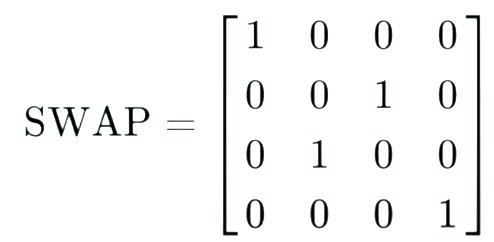
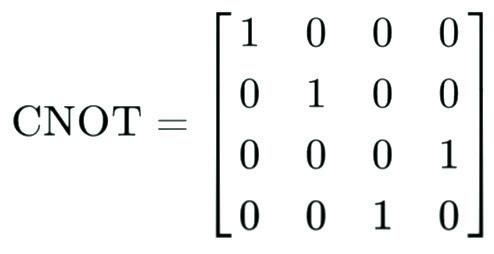

5. Qubits
ere are several di erent types of qubits and this article will be covering the three most common types: electrons in atoms or ions, photons, and superconducting circuits.
The Phase Shift Gate, or the P gate, takes a real number and rotates the qubit around the Z axis of the Bloch Sphere for radians [17]. The Z Gate is equivalent to P(π). To represent 90° degree turns around the Z axis of the Bloch Sphere, the S gate, or the Gate is used which is equivalent to P(π/2) [17]. Similarly, to represent a 45° degree turn, the T gate, or the Gate is used which is equivalent to P(π/4) and the inverse of the T gate, the gate is equivalent to P(-π/4) [17].
Subatomic particles, like electrons, have an inherent property known as spin, which is a type of angular momentum [18]. ey naturally behave as if they are spinning and initially have a non-zero angular momentum despite not rotating around another object [18]. us using the property, we can nd that the electron is either in the spin state ‘spin up’, if it is ‘rotating’ clockwise or the spin state ‘spin down’ if it is ‘rotating’ anticlockwise [18]. e spin states ‘spin up’ and ‘spin down’ corresponds to the | 0 > or | 1 > eigenstates [19]. We can also alter their energy state (switching between their natural state and their “excited” state) using lasers to represent the two eigenstates.
Photons, which are very small ‘packets’ of light, can also be used in several ways to model the two eigenstates [19]. Path qubits model the eigenstates by having a single photon pass through a beam splitter which has two light detectors on their respective sides. is causes either light detector to detect a photon 50% of the time but never at the same time, as the photon cannot be split [20].
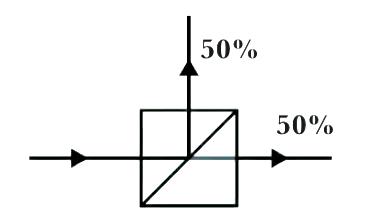
Some gates perform operations on two qubits. For example, the controlled-NOT gate or the CNOT gate inverts the other qubit if the indicator qubit is | 1 > [15]. For example, if the indicator qubit is | 1 > and the other qubit is | 0 >, the result would be | 1 1 >.
Another important widely used gate is the SWAP gate which swaps the values of the two qubits with each other [15]. For example, two qubits with states | 1 0 > will result in | 0 1 > after the SWAP gate is applied to it.
e top light detector can represent a | 0 > state and the bottom light detector can represent a | 1 > state [19]. Another property of photons is that they have one of two polarisations (horizontal [H] and vertical [V]) perpendicular to the direction of wave propagation as light is a transverse wave which oscillates. ese photons can also exist in a superposition of the two polarisations or have one of the two polarisations, thus they are known as polarisation qubits. Calculations can be made when passing these photons through a horizontal or vertical polariser. A horizontal polariser will let a photon with a horizontal polarisation through but not a photon with a vertical polarisation and vice versa for the vertical polariser [20]. e probability that a photon with a superposition can pass through the horizontal polariser will be |α|2 whilst the probability it will pass through the vertical polariser will be |β|2 [20].
Unlike classical computers where there are multiple electrons in a DRAM circuit for redundancy in case of electron leaks, qubits in quantum computers can be easily collapsed when they interact with other subatomic particles and struggle to work with bigger bits with more electrons [21]. However, this means that they would be vulnerable to electron leakage. A solution around this is superconducting circuits, which are certain metals that are cooled down to nearly 1°K so that their electrons are joined together as a unit and do not scatter around [21]. We can measure the energy level of the electrons or the direction of current to represent the two eigenstates of the qubit [19, 21].
6. Advantages
One of the most important features of quantum computers is their computational power and speed. Unlike supercomputers, quantum computers can double their computational speed by adding a single qubit [9]. Given that IBM released their 5-qubit quantum computer in May 2016 and has created a computer with 25.4 times more qubits in just over 5 years, the potential for quantum computers is huge [22]. They also have the ability to solve complex problems that have many interacting variables and run multiplex simulations due to superposition and entanglement [23]. For example, Quantum Computing Inc (QCI) has designed quantum computers which have been used to solve a 3854-variable optimization problem with 500 constraints for placing vehicle sensors in a BMW in under six minutes and they were able to find a solution with 96% vehicle coverage with only 15 sensors [24]. Aside from cars, quantum computers can be used in other fields for cryptography, chemistry, medical usage, modelling, forecasting, and much more [6, 23]. Quantum computers also have a lower lower bound than classical computers at regular processes like ordered searching [ log (n) compared to log (n)], comparison-based sorting [O(n) compared to O(n log n)] and element distinctiveness [O(√n) compared to O(n log n)[25] In addition to these advantages, quantum computing is also environmentally friendly and requires only 0.002% of the energy used by a classical computer [26].
7. Disadvantages
Although quantum computers can be used in a variety of different fields, they are unable to solve most problems with 100% accuracy that can be solved with classical computers easily due to their probabilistic nature [16]. Quantum computers are also unable to store data and most memory can only be stored for up to a few hundred microseconds (10-6 s).
To reduce errors in qubits, they also have to be stored in extremely cold temperatures (3 °K) and require huge machinery as well as energy [27]. Although there have been many recent advancements, we are still far away from unleashing the full potential of quantum computing as quantum computers with hundreds or thousands of qubits are extremely complicated and difficult to build as qubits tend to have lower connectivity (communication within qubits) in larger quantum machines [27]. Due to its technical limitations, the difficulty of building a supercomputer and the extreme environment needed to store a quantum computer, a McKinsey report predicts that there will still be less than 5000 quantum computers by 2030, compared to over 2 billion computers today [27]. However, the rise of quantum computing means that many companies will now be at risk of being hacked by quantum computers as they will be able to break current cryptographic algorithms with ease [28]. They are also very expensive and cost tens of millions of dollars for one.
8. Cryptography
Currently, there have been multiple quantum computing algorithms such as Shor’s algorithm and Grover’s algorithm which have been developed to crack encryptions such as RSA (involves multiplying two huge prime numbers together), TDES or AES. Shor’s algorithm helps decrypt encryptions like RSA as it is able to find the decomposition of any integer into two primes in O(d3), where d is the number of digits that the integer has in decimal, which is a massive speedup compared to the exponential time complexity of classical computers [29].This time is very short considering that the upper bound of RSA integers is around 2470 digits long. Grover’s algorithm can help crack symmetric key algorithms with a lower number of bits. Using quantum computation to search for elements in an unstructured database allows for an O(√n) time complexity compared to O(n) in classical computers [30]. Although this is only a quadratic speed-up, this is already enough to crack any key size of TDES and up to 128-bit AES [30, 31]. However, quantum computing is still in its infancy stage and quantum scientists have not been able to use these algorithms to decrypt huge numbers currently used today. Despite this, many companies have invested in quantum-safe algorithms like CRYSTALS-Kyber, CRYSTALS-Dilithium and Falcon [31].
8. Chemistry
In quantum chemistry, ab initio (“from first principles”) calculations try to solve the electronic Schrödinger equation, = , given the position of the nuclei and number of electrons to find its energy and wave function, which can be derived to find electron densities, electron distribution and any other properties of the system [32]. As the calculations are very complex and are probabilistic, quantum computers have been used to represent states of a quantum chemical system to simulate quantum physics. Although current quantum computers have a relatively low number of qubits and have limited gate operations, future quantum computers with more qubits will be able to run a quantum phase estimation (QPE) algorithm which can solve for any variables in polynomial time, a time that is unreachable for classical computers [33]. Currently, quantum computers by IBM have been successful in doing some ab initio molecular dynamic methods (simulation of physical movement of subatomic particles) with fairly high precision on simpler elements like hydrogen and even beryllium hydride [33, 34].
9. Prediction
Weather forecasting, stock market analysis, and predictions are all very complex and take lots of computational power to get an accurate prediction. These can be solved through quantum computing, as properties of superposition allow for the handling of huge numbers of variables interacting in a non-trivial way, which can reduce the damages of natural disasters as the predictions will become more accurate and precise [35]. Through the use of qubits, quantum machine learning algorithms can also be developed for pattern recognition with huge datasets and performing classification of data [35]. This could help increase investment gains, open new investment opportunities and reduce the risk of trading [36]. Additionally, it can help detect fraud (over $10 billion is lost per year due to fraud in the US), money laundering and forecast crashes in the markets which can save billions and billions of dollars [36]. Quantum computers can also help with recommender systems and social media algorithms.
10. Conclusion
Despite the extreme conditions, expenses, and issues raised due to quantum computing such as privacy concerns, quantum computing will surely become one of the most important industries in the world within a decade due to its strong ability to solve very hard optimization problems in a short amount of time. Although quantum computing is still in its infancy, its applications in so many different fields like cryptography, chemistry and forecasting still shock many and are full of potential. Through further research by scientists, I believe that quantum computers with thousands of qubits, which can perform P or even NP problems in very little time, can be made in ten to fifteen years given the exponential growth of quantum computing technology and rising awareness surrounding this technology.
*Note that this article does not cover more advanced topics such as quantum interference or quantum algorithms or applications of quantum gates to make this more simple and digestible for the reader.
11. Bibliography
[1] “Global Tourism - Industry Data, Trends, Stats | IBISWorld.” IBISWorld - Industry Market Research, Reports, & Statistics, https://www.ibisworld.com/global/ market-research-reports/global-tourism-industry/.
[2] “Quantum Computing Is Coming. What Can It Do?” Harvard Business Review, https://www.facebook.com/HBR, 16 July 2021, https://hbr.org/2021/07/quantum-computing-is-coming-what-can-it-do.

[3] Lu, Donna. “What Is a Quantum Computer?” NewScientist, https://www.newscientist.com/question/what-is-a-quantum-computer/.
[4] “Google AI Blog: Quantum Supremacy Using a Programmable Superconducting Processor.” Google AI Blog, https://ai.googleblog.com/2019/10/quantum-supremacy-using-programmable.html.
[5] Aaronson, Scott. “The Limits of Quantum.” SciAm, SpringerNature, 2008, https://www.cs.virginia.edu/~robins/The_Limits_of_Quantum_Computers.pdf.
[6] Bellapu, Apoorva. “10 Difficult Problems Quantum Computers Can Solve Easily.” AnalyticsInsight, https://www.analyticsinsight.net/10-difficult-problems-quantum-computers-can-solve-easily/.
[7] Choi, Charles Q. “Two of World’s Biggest Quantum Computers Made in China - IEEE Spectrum.” IEEE Spectrum, IEEE Spectrum, 6 Nov. 2021, https://spectrum.ieee.org/quantum-computing-china.
[8] “IBM Unleashes the Eagle, the World’s Most Powerful Quantum Processor.” New Atlas, 17 Nov. 2021, https://newatlas.com/quantum-computing/ibm-eagle-quantum-processor/.
[9] Voorhoede, De. “Superposition and Entanglement.” Quantum Inspire, https://www.quantum-inspire.com/kbase/superposition-and-entanglement/.
[10] Quantum Superposition, Explained Without Woo Woo, YouTube, uploaded by TheScienceAsylum, 29 Nov 2021, https://www.youtube.com/watch?v=ZUipVyVOm-Y
[11] The Bloch Sphere (simply explained), YouTube, uploaded by mu-hoch-3, 11 Jun 2020, https://www.youtube.com/watch?v=a-dIl1Y1aTs
[12] Contextual Semantics: From Quantum Mechanics to Logic, Databases, Constraints, and Complexity - Scientific Figure on ResearchGate.
[13] Quantum Computers: Superposition, Entanglement, and Qubit, Youtube, uploaded by ScienceyStuff, 9 Apr 2020, https://www.youtube.com/watch?v=x3LmP-
FSZAAU
[14] Is entanglement the key to quantum computing?, Youtube, uploaded by LookingGlassUniverse, 8 May 2021, https://www.youtube.com/watch?v=4RTxJ_I9LtU
[15] Quantum Gates, Youtube, uploaded by Travis Gritter, 6 Feb 2017, https://www.youtube.com/watch?v=gz5rjhiU4ao
[16] Quantum Computers Explained - Limits of Human Technology, Youtube, uploaded by Kurzgesagt - In a Nutshell, 8 Dec 2015, https://www.youtube.com/ watch?v=JhHMJCUmq28
[17] The Qiskit Team. “Single Qubit Gates.” Qiskit.Org, Data 100 at UC Berkeley, 6 July 2022, https://qiskit.org/textbook/ch-states/single-qubit-gates.html.
[18] Spin in Quantum Mechanics: What Is It and Why Are Electrons Spin 1/2? Physics Basics, Youtube, uploaded by Parth G, 4 Nov 2020, https://www.youtube. com/watch?v=DCrvanB2UWA
[19] “What Is a Qubit? | Institute for Quantum Computing.” University of Waterloo, https://uwaterloo.ca/institute-for-quantum-computing/quantum-101/quantum-information-science-and-technology/what-qubit
[20] Quantum Mechanics 2 - Optical Qubits: Polarisation and Interference, Youtube, uploaded by Centre for Quantum Technologies, 12 Oct 2021, https://www. youtube.com/watch?v=sTxQZcTSw-4
[21] Building a quantum computer with superconducting qubits (QuantumCasts), Youtube, uploaded by TensorFlow, 8 Feb 2019, https://www.youtube.com/ watch?v=uPw9nkJAwDY
[22] “Five Experimental Tests on the 5-Qubit IBM Quantum Computer.” SCIRP Open Access, https://www.scirp.org/journal/paperinformation.aspx?paperid=86139.
[23] FutureLearn. “What Is Quantum Computing? Essential Concepts and Uses - FutureLearn.” FutureLearn, https://www.facebook.com/FutureLearn, 15 Oct. 2021, https://www.futurelearn.com/info/blog/what-is-quantum-computing.
[24] Pires, Francisco. “BMW’s 3,854-Variable Problem Solved in Six Minutes With Quantum Computing | Tom’s Hardware.” Tom’s Hardware, Tom’s Hardware, 28 July 2022, https://www.tomshardware.com/news/quantum-computing-company-solves-3854-variable-problem-for-bmw-in-six-minutes.
[25] Hoyer, Peter, et al. “Quantum Complexities of Ordered Searching, Sorting and Element Distinctness.” ArXiv, 15 Feb. 2001, https://arxiv.org/abs/quantph/0102078.
[26]Wu, Tin Lok. “What Is Quantum Computing and How Can It Help Mitigate Climate Change? | Earth.Org.” Earth.Org, Earth.Org, 22 Aug. 2022, https:// earth.org/what-is-quantum-computing/.
[27] “Will Quantum Computing Replace Traditional Methods? | Built In.” Built In, https://builtin.com/software-engineering-perspectives/quantum-classical-computing.
[28] “The Impact of Quantum Computing on Society | Post Quantum Cryptography | DigiCert.” SSL Digital Certificate Authority | Encryption & Authentication | DigiCert.Com, https://www.digicert.com/blog/the-impact-of-quantum-computing-on-society.
[29] “Shor’s Algorithm - IBM Quantum” IBM Quantum, https://quantum-computing.ibm.com/composer/docs/iqx/guide/shors-algorithm.
[30] Mina-Zicu, M.; Simion, E. Threats to Modern Cryptography: Grover’s Algorithm. Preprints 2020, 2020090677
[31] “What Is Quantum-Safe Cryptography, and Why Do We Need It? | IBM.” IBM - United States, https://www.ibm.com/cloud/blog/what-is-quantum-safe-cryptography-and-why-do-we-need-it.
[32] Cyanide, Mohsin. Ab Initio Calculations and Modelling in Computational Chemistry. YouTube, 9 Jan. 2022, https://www.youtube.com/watch?v=LRK0zgNjPl8.
[33] Fedorov, Dmitry, et al. “Ab Initio Molecular Dynamics on Quantum Computers.” ArXiv.Org, 14 Aug. 2020, https://arxiv.org/abs/2008.06562.
[34]“Science | AAAS.” AAAS, https://www.science.org/content/article/quantum-computer-simulates-largest-molecule-yet-sparking-hope-future-drug-discoveries?cookieSet=1.
[35] Dutta, Aratrika. “Quantum Predictions: Weather Forecasting with Quantum Computers.” Analytics Insight, 27 Sep. 2021, https://www.analyticsinsight.net/ quantum-predictions-weather-forecasting-with-quantum-computers/.
[36] “Quantum Computing Use Cases for Financial Services | IBM.” IBM, https://www.ibm.com/thought-leadership/institute-business-value/report/exploring-quantum-financial.
[37] “The No-Cloning Theorem | Quantiki.” Quantiki | Quantum Information Portal and Wiki, https://www.quantiki.org/wiki/no-cloning-theorem.








